As someone with a somewhat similar inflammatory autoimmune bone condition called ankylosing spondylitis, I can personally relate to many of the symptoms and struggles of those with rheumatoid arthritis (RA). Just as certain types of exercise can help reduce inflammation in my spine and SI joints, the same applies to rheumatoid arthritis. Previous research shows that regular exercise can lower the levels of inflammatory markers in the body, as well as many other benefits that also come along with moving your muscles.
Exercise triggers certain hormones and cytokines or proteins that help modulate inflammation. Recently, researchers explored the value of blood-flow restricted resistance training for those with rheumatoid arthritis. Let’s explore.
The study

In a study published in the journal Disability and Rehabilitation, researchers analyzed a cross-sectional survey with the exercise preferences of 97 people with rheumatoid arthritis and a single-group trial of 12 participants. In this two-part study, the researchers aimed to explore the attitudes and preferences of individuals with rheumatoid arthritis toward blood flow restricted resistance training (BFR-RT) and to assess the impact of a progressive upper and lower body BFR-RT intervention.
How does BFR-RT impact muscle strength, quality of life, functional capacity, and pain in individuals with RA?
What is blood-flow-restricted training?

BFR training or occlusion training involves placing a cuff around the working limb, such as your arm or leg, to help restrict some of the blood flow during exercise. Cuffing your limb and restricting blood flow to your arm during a resistance training exercise like a bicep curl allows you to use lighter weights while still allowing for muscle growth and strength.
Restricting blood flow induces metabolic stress within the muscle, similar to higher-intensity training, making it particularly useful for those who can’t lift heavier weights or perform more vigorous resistance training workouts.
The results

The study revealed:
- Upper- and lower-body blood flow-restricted resistance training can improve the outcomes of RA.
- Those with RA preferred BFR-RT when supervised by an exercise professional, when it was low-to-moderate intensity, and no more than three sessions every week.
- In the BFR-RT trial, 100% of the participants liked the program, and 81% were able to adhere to the workout sessions.
- The BFR-RT trial resulted in notable improvements in functional performance in the lower extremities, muscle strength, and the perception of pain. There were no improvements in the quality of life.
Concluding thoughts

People with rheumatoid arthritis usually deal with frequent or even constant pain that can be a barrier to exercise. They might be more willing to complete a workout that they perceive to be less painful, such as BFR-RT, especially if they can get similar results without lifting the heavier weights. If they have to push through less discomfort, individuals might be better able to complete the workouts and experience the anti-inflammatory benefits.
Overall, BFR-RT is another viable option for many people with rheumatoid arthritis, and this study shows it’s viewed more positively, has high adherence, and can improve strength and function.




